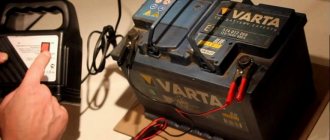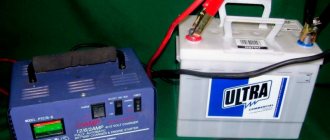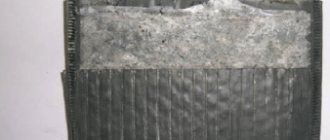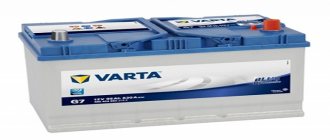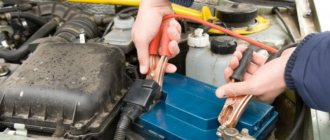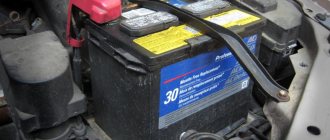Recently, more and more gel car batteries, also called AGM, have appeared on the shelves of Russian stores. They have a number of advantages over battery models with liquid electrolyte, as well as a number of disadvantages. And one of these disadvantages is that gel batteries require the correct charging process. And you need to know exactly how to charge a car's gel battery. We’ll talk about this in this article, but first a short digression about the gel-filled batteries themselves.
Technical features of GEL batteries
Without really understanding the technology, many “experts” like to say that gel batteries are a new product, something extremely high-tech, complex, and so on. Not really. Of course, gel electrolyte in power supplies began to be used much later than liquid electrolyte. But not yesterday, and not even the day before yesterday.
If you believe history, the first gel batteries appeared at the dawn of the development of space technology. And this, for a second, is more than half a century ago. An air conditioner with a navigator, for example, is much “younger”. Although for many these are far from new technologies. To be fair, we note that GEL batteries came to the automotive industry relatively recently. But only because they are incredibly expensive.
The design of a classic gel battery is not much different from the standard one that everyone is used to. The same sealed case. Inside there are lead plates from which the cells are assembled, and they are already connected to form a battery. But the electrolyte here is gel. That is, it has a gel-like consistency. In addition, while some gels in nature have at least some fluidity, in batteries it is closer to a solid than to a liquid.
People say that especially carefully purified lead is used to make GEL batteries. Actually this is not true. Lead is purified in the same way during the production of any other modern battery. Although in some cases this point is presented as a feature of gel batteries in order to justify their high cost.
Let's summarize. There is nothing extra natural in GEL technology. However, the fact that the electrolyte in them has a gel-like consistency is important for answering the question - how to charge a gel battery. Therefore, we will return to this later.
Advantages and disadvantages
Gel battery manufacturing technology has the following advantages:
- No electrolyte leakage in any position.
- Long service life - up to 700 cycles (sometimes up to 1000 or more).
- Good current performance even with reduced capacitance.
- Maintains functionality in any position: tilted, upside down.
- No fumes hazardous to health.
- Higher starting current, which is important when operating the machine in winter.
- No fear of temperature changes and preservation of properties at high / low temperatures.
- Possibility of discharge to zero without serious consequences for the battery.
Minuses:
- Strict requirements for operating rules.
- The need to use automatic chargers with current/voltage regulation.
- High price due to the complexity and high cost of the technology.
- Risk of battery damage due to voltage/current surges.
Is it possible to charge gel batteries at all?
At one time (and maybe even now) there was a story that it was impossible to charge gel batteries at all. Most likely, this myth was created by those who tried to charge, but did it incorrectly. As a result, the battery swelled, lost its capacity irrevocably, or stopped taking a charge altogether. This is not very difficult to achieve. It will become clear later how.
It is possible, and even necessary, to charge gel batteries. The myth in question is so stupid that there is no particular desire to write about it. But you have to. Remember once and for all: if something is called a battery, then it can be charged. And it doesn’t matter what technology it was made using. The key word here is battery - a reusable power source.
But you need to charge the GEL battery correctly. By erroneous actions, it can be damaged in just one charging cycle.
Basic mistakes
When charging a gel battery, car owners make the following mistakes:
- Increasing the permissible voltage threshold above normal. The result of this step is the boiling of the gel.
- Attempts to “revive” a swollen battery. This will not give any results.
- Use conventional chargers designed for acid-based devices.
- Driving the vehicle until the battery is completely discharged. It is important to note that a completely dead battery is much more difficult to restore.
Is it worth buying a GEL battery for a car?
Let's briefly consider whether it is worth giving preference to a gel battery, abandoning more affordable options. To draw conclusions, we need to go over the advantages of the technology, as well as our main topic - charging.
Manufacturers and sellers attribute the following advantages to GEL batteries:
- increased service life;
- can be tilted and flipped;
- efficient charge reception;
- insensitivity to deep discharges;
- low self-discharge.
All these advantages are really not invented for the sake of advertising and justifying the high cost of gel batteries. They really can last a long time, they can be discharged to zero, and they themselves discharge very, very slowly. But only under one condition - if the GEL battery was charged correctly throughout its service life.
Therefore, if you are not sure that you can charge a gel battery as described below, then it is better not to buy it. First, overpay for benefits you'll never get. Secondly, today there is a worthy and more affordable alternative. In the end, even conventional batteries with liquid electrolyte in modern design can last much longer than the required 5 years. Albeit with some reservations. And for a car battery, such a lifespan is an achievement that deserves respect.
Do these batteries need to be serviced?
Gel batteries do not require maintenance and are often produced in a sealed case, because the gel cannot be filled.
Manufacturers indicate a battery life of 10 years. However, such long-term operation can only be achieved by following all operating rules. The service life of these devices is negatively affected by both too low (less than -30°C) and high temperatures (more than +50°C). Therefore, it is recommended to store the gel storage device in a warm, dry place in winter.
Also, battery life is negatively affected by overcharging the battery. Constant undercharging is also undesirable.
Such devices can store energy for quite a long time, but they still need to be recharged, which is carried out at least once a season.
About special chargers for GEL batteries
They were invented for those car enthusiasts who could not or did not want to figure out how to charge a gel battery. Naturally, they cost much more than regular good chargers. But what can they do that we, car enthusiasts, have to overpay for? And nothing except limiting the charge voltage at a certain level.
Moreover, many “special” chargers for GEL-type car batteries cannot even do this. Because you know where they were made. The author of the article had the opportunity to repair this kind of charger several times, and disassembly clearly proved the above. The circuitry of some models does not even come close to stabilizing or limiting the charging voltage. Meanwhile, this is the most important thing for a gel battery...
So be very careful about how you choose your battery charger.
Battery maintenance after charging
Gel batteries are almost impossible to maintain, since they are not repairable and, if they break, it is easier to buy a new one. But still, there is a way to increase the density of the gel - distilled water. It is poured into each of the 12 Volt battery tanks in a volume of 2 ml using a syringe.
You should not close the lids immediately; you need to wait 2-3 hours until the liquid is absorbed into the gel and this reaction is completed. After screwing on the caps, the voltage at the terminals is checked; if it is normal, the battery can be recharged. True, its service life will be reduced with such a life hack. Increasing density along with regular recharging are all options for servicing gel batteries.
Gel batteries are more durable than acid batteries, operate more stable and emit fewer harmful substances. They also need to be charged periodically, but this cannot be done with a regular charger. We need an advanced charger that will not only not damage the battery, but will also transfer the required amount of energy into it.
How to charge a gel battery
Let's return briefly to the technical features of gel batteries, as promised above. Namely, to the gel-like state of the electrolyte. When, during the charging process of a conventional battery, the voltage exceeds the norm (14.4 V), the liquid electrolyte begins to “boil”. What happens in this case, read the article - why the battery boils.
A gel-like electrolyte cannot boil due to its state of aggregation. But it can peel off, that is, lag behind the lead plates. This process is in most cases irreversible. As a result, the contact area between lead and electrolyte decreases. And at the same time, the battery capacity decreases and the maximum starting current decreases. Moreover, in this situation, there is a high probability that the battery case will swell or even collapse.
From all this, the main rule for charging a gel battery follows: in no case should the charge voltage be exceeded . The norm here, as for conventional car batteries, is 14.4 V. The maximum is -14.5 V. If you charge the battery and apply more voltage to it than specified, this will lead to peeling of the electrolyte from the lead plates.
For this reason, it is highly recommended that you have:
- A charger in which the voltage is limited electronically, or this can be done manually.
- The device for control measurement of charge voltage is a multimeter.
Almost any charger that provides classic modes or manual voltage adjustment is suitable for the first one. As a matter of fact, even homemade memory devices with such adjustments can also be used. The main thing is not to miss when, during the charging process, the voltage begins to increase and exceed the specified values.
A multimeter is needed in any situation. Even if there is such a device on the charger, it is not a fact that it reflects what it really is. First, built-in voltmeters are often not calibrated. Second, they measure the voltage at the output of the device circuit. And it is important for us to know and control the voltage that is available directly at the terminals of the gel battery. You can accurately measure it using a multimeter connected directly to the terminals.
Practice shows that for this task it is not advisable to buy an expensive electronic multimeter. Such devices, as radio amateurs say, “take a long time to think.” This means they show the voltage with a slight delay. Therefore, for additional control, buy inexpensive multimeters. Although they are not as accurate, they are “fast”. And their accuracy is usually enough not to destroy the gel battery when charging. As a last resort, you can calibrate the multimeter...
Gel battery charging algorithm:
- It is advisable to disconnect the battery from the on-board network. This is not necessary, since the battery will be charged at a safe voltage. For what we are talking about, read the article on how to charge a calcium battery.
- Connect a test voltmeter (multimeter) to the battery terminals.
- Turn on and configure the charger in accordance with its operating instructions.
- If it is possible to select the charge current, set it to 10% of the actual capacity (not the one written on the case).
- If voltage regulation is provided, it should be limited to 14.4 V.
- Connect the charger to the terminals of the gel battery.
- Monitor charging current and voltage. The indicators should not be higher than those indicated in paragraphs 4 and 5.
- When the charging current drops to 0.1-0.3 A at a voltage of 14.4 V, the gel battery can be considered fully charged.
- If the charger is manually controlled, it is advisable not to miss this moment, so as not to overcharge.
- Automatic chargers will turn off the charge on their own. Although they often do it ahead of time.
How to make sure that the charging of the gel battery was successful? For obvious reasons, we cannot measure the density of the electrolyte. There is also no green indicator, as in conventional batteries, since it only works in a liquid medium. All we have in this case is resting tension. To determine from it how much the gel battery is charged, you need to measure it correctly, and then compare the indicators with the data in the table below.
Quiescent voltage is the voltage at the terminals, which is measured after 8-12 hours of battery inactivity . That is, after you have charged the gel battery (or any other), let it stand without operation for the specified time or longer. Then measure the voltage at the terminals. The resulting indicators will be the resting voltage. Here is the table.
| Quiescent voltage (V) | Charge(%) |
| <11,90 | 0 |
| 11,95 | 10 |
| 12,00 | 20 |
| 12,05 | 30 |
| 12,15 | 40 |
| 12,20 | 50 |
| 12,30 | 60 |
| 12,40 | 70 |
| 12,50 | 80 |
| 12,60 | 90 |
| 12,70 | 100 |
| >12,71 | Incorrect measurement |
A few words should be said about incorrect measurements. Very often, after being idle for 8-12 hours, the resting voltage is not reached. That is, the voltmeter shows 13 volts, and even more. Don't think that your battery is something special. No. It’s just that the resting tension has not yet been achieved. As a rule, if after charging a gel battery it is immediately connected to the on-board network and just stands “idle”, the resting voltage is reached in 6-7 hours.
Separately from the on-board network you have to wait a little longer. One way or another, if you charged a gel battery today, and in the morning the voltmeter showed more than 12.7 V, then there is every chance that you did everything as it should. The battery is charged and ready for further use. If the rest voltage is somewhere within the above plate, that is, less than 12.7 V, then the battery was not fully charged.
Don't forget about three important factors when measuring resting voltage. Firstly, if the battery is left connected to the on-board network, then in 8-12 hours it can be slightly discharged by the car’s devices operating in standby mode. Secondly, there is such a thing as a large leakage current. Thirdly, self-discharge should not be written off either. For gel batteries it is extremely low while they are new. If yours is several years old, then the self-discharge can be quite significant...
Charging in the machine
To charge the battery in the “Automatic” mode, if such is provided on the charger, no special adjustments should be made. It is necessary to connect the alligator clips to the battery terminals, turn on the charger in the “automatic” and “GEL” modes, and wait for the message about the end of charging.
When using an automatic charger for the first time, you should independently monitor the voltage (preferably current) on the charger after half an hour. The fact is that some Chinese chargers do not set the charge voltage quite correctly. This is important for the “Gel” mode.
Do I need to charge a new gel battery?
This topic is discussed in great detail in the article - whether it is necessary to charge a new battery. What is said in it applies to both conventional batteries and gel ones. If you’re too lazy to read or don’t have time, here’s a quick answer to the question: a new gel battery needs to be charged, but not always . It happens that out of the package the battery is already normally charged. The main thing is to know how to determine this correctly. This is also described in the article linked above.
Which charger should you purchase for a gel battery?
An ideal memory should:
- have manual adjustments of voltage and charge current;
- there must be an automatic three-stage charging mode for gel batteries (preparation, main, additional charge) or four-stage (plus storage);
- have thermal compensation to prevent overcharging, which leads to a decrease in battery life;
- have a built-in current and voltage measuring device, a cooling fan speed controller;
- provide a maximum temperature range.
The preparatory mode provides direct current charging , while the voltage on the battery increases. It is important that the voltage for gel batteries does not exceed 14.4 Volts.
The main charge is carried out at a constant voltage with decreasing current.
The final recharge occurs at a minimum current and reduced voltage .
Brief summary
Charging a gel battery is not much different from a similar procedure with classic car batteries. There is only one important rule - do not exceed the charge voltage. If this moment is missed, the GEL battery will deteriorate irrevocably. The gel-like electrolyte will lag behind the lead plates, the capacity will decrease, the inrush current will possibly inflate the case. Later, such a battery may “refuse” to accept a charge.
If you have anything to add to this material, write your thoughts in the comments. Useful information will definitely be useful to someone, and can also be added to this article.
Distinctive features from conventional batteries
A gel battery is an optimized version of the classic battery, which has a similar operating principle, but a different design.
The main feature is the replacement of the electrolyte-liquid with a gel.
The advantage of the technology is to protect the working fluid from leakage, regardless of the position of the housing, which made the battery in demand among owners of motorcycles, cars, and watercraft.
Charge saving mode
There is another feature - charge to save charge. On many gel batteries it is called Standby USE (waiting for use). Since the battery can be stored for years without recharging, it needs to be recharged occasionally. As the manufacturers write, once a year is enough. So you need to charge with a special voltage - from 13.5 to 13.8V.
In this mode, the battery will gain energy without harming itself and you can leave it to “save” for a long time.
A few words about the structure
I don’t want to go into too much detail now - let’s remember the main aspects:
- These batteries also have 6 insulated jars (compartments), just like regular acid ones. Each bank produces about 2.1 Volts, total voltage 12.6 - 12.7V
- Purified lead is used in the structure of the plates , so the resistance is much lower than that of conventional batteries. And this promotes rapid charging and discharging. Therefore, starting currents can reach up to 1000 Ah.
- Instead of liquid electrolyte , the plates are sealed in a special gel; it acts as a holding element for the electrolyte (seals it inside), and also acts as a dielectric (prevents plates with different poles from shorting). Another positive point is that the gel is poured liquid at the factory, after which it becomes a hard mass, it envelops the plates and does not allow them to crumble - therefore, such batteries are resistant to deep discharges .
- The battery can be placed on its side or upside down (the main thing is not to short-circuit the terminals), the electrolyte will not leak out, there is an atmosphere inside the battery (it is sealed), and it is not advisable to destroy the case. For the same reason, boiling off of the electrolyte is impossible!
- He is not so afraid of the cold, of course it has a lower limit, but it is within the range of 50 degrees, which is difficult to meet in the middle zone.
In general, the battery is simply a miracle, it produces high currents, does not discharge in cold weather, does not need to be topped up with electrolyte, etc. But what is his “Achilles heel”, where are his weak points?
